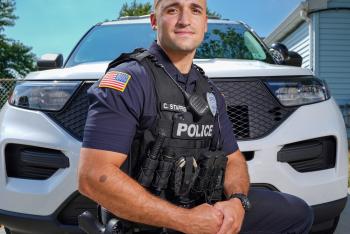Shoulder pain can result from injuries, arthritis or other conditions, and determining the right...
Read More

In his career as an orthopedic surgeon, Mark Ayzenberg, M.D., had never encountered a latissimus tendon tear. That is, until last year when a local police officer came to him for help. “I tried reaching out to a number of shoulder surgeons across the country who might have seen this injury in the past,” said Dr. Ayzenberg. “But the surgery is so rare and complex that none had ever performed one, even among the top specialists in the U.S. And there were only case reports and small series describing this in the literature.”
The latissimus tendon does not rupture easily—out of 25 fellowship-trained surgeons that Dr. Ayzenberg reached out to, only one had encountered a patient with this type of injury in a patient who did not need surgery. Some specialists won’t attempt a latissimus tendon repair because of the risks associated with the procedure.
“The tendon is a thin sheet that’s surrounded by major nerves and arteries, including the brachial plexus,” said Dr. Ayzenberg. “When drilling through the bone to reattach the tendon, there’s a possibility of hitting the brachial plexus, or even wrapping up arteries around the drill, which would result in an injury much worse than the tendon tear itself.”
Although it was his first time performing a latissimus tendon repair, Dr. Ayzenberg built trust with his patient prior to proceeding with the surgery. The surgery was a success—the patient is now back to his full-time police duties and working out at the gym regularly. “I spoke to him 9 months after the surgery and he’s already back to doing pull-ups in the gym,” said Dr. Ayzenberg.
Dr. Ayzenberg wanted other surgeons to learn from his experience with this rare surgery, so he filmed both his practice cadaver dissection and the surgery itself. “I looked at everything I could find about latissimus tears and how to fix them, but there’s not enough information for many surgeons to feel comfortable jumping into it,” he said. “For example, in my research, I realized that all the anatomy books draw the arm at one’s side, but during this type of surgery the arm must be over the head, which changes the position of the anatomy.”
While Dr. Ayzenberg’s goal was to educate other surgeons on this procedure, it resulted in the unexpected: Another man with a latissimus tear reached out to him—from nearly 6,000 miles away.
Dr. Ayzenberg’s second latissimus tear patient reached out from a country known for its advanced healthcare. He had been looking for someone to repair his injury for almost six years. “This patient was extremely well-educated on his injury, and had found me from my YouTube video when conducting research online,” said Dr. Ayzenberg. “He reached out hoping that I could perform his tendon repair.”
Most recorded latissimus tendon surgeries happen within weeks or months of the injury, so this patient’s situation was especially unique and the outcome was unpredictable. “With an injury that old, the muscle starts to die,” said Dr. Ayzenberg. “Before this patient flew to the U.S., we looked at an MRI and couldn’t see the tendon. And to make things more complicated, he had prior surgeries in the same area so there was existing scar tissue that we would have to work around. So, he came here understanding that we were planning an exploration procedure and potential repair—but only if the tendon was still viable.”
During the procedure, Dr. Ayzenberg’s team discovered a proximal injury to the tendon, but it was not torn completely off the bone. “It took a bit of figuring out how to repair this injury while we were in the operating room, but ultimately we folded the tendon over the muscle belly to repair the myotendinous junctional injury and then repaired it all the way back to the bone,” he said. Within days of surgery, the patient felt a difference—his muscle tension was restored.
After completing some physical therapy and taking time to heal, the patient flew back home. “Overall, I expect his prognosis will be good,” said Dr. Ayzenberg. “He feels good and is motivated, and I’m hopeful that within a year he will be back to everything he wants to do.”
In a text message sent to Dr. Ayzenberg about nine weeks post-op, the patient provided an update: “I feel absolutely amazing, improving every day. I have near full range of motion and I’m starting to get my strength back.”
Dr. Ayzenberg expressed his gratitude to the team at Mullica Hill, including the OR nurses, anesthesiologists and physical therapists. And while he doesn’t expect to see another latissimus tear in his career, he acknowledged that anything is possible. “It would have been easy not to pursue a treatment for my first patient with this injury,” he shared. “Just because you haven’t heard of something doesn’t mean it doesn’t exist. If a patient says they feel that something is wrong, as surgeons, we have the responsibility to check into it and provide care to the best of our ability.”

Shoulder pain can result from injuries, arthritis or other conditions, and determining the right...
Read More
What happens when you injure yourself in a way that no surgeon in your area has ever seen, much less...
Read More
Exercise is vital to good health, but sports and other physical activities can cause injury. Here’s...
Read More
The material set forth in this site in no way seeks to diagnose or treat illness or to serve as a substitute for professional medical care. Please speak with your health care provider if you have a health concern or if you are considering adopting any exercise program or dietary guidelines. For permission to reprint any portion of this website or to be removed from a notification list, please contact us at (856) 537-6772